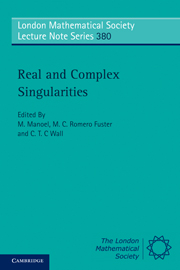Book contents
- Frontmatter
- Contents
- Preface
- 1 On a conjecture by A. Durfee
- 2 On normal embedding of complex algebraic surfaces
- 3 Local Euler obstruction, old and new, II
- 4 Branching of periodic orbits in reversible Hamiltonian systems
- 5 Topological invariance of the index of a binary differential equation
- 6 About the existence of Milnor fibrations
- 7 Counting hypersurfaces invariant by one-dimensional complex foliations
- 8 A note on topological contact equivalence
- 9 Bi-Lipschitz equivalence, integral closure and invariants
- 10 Solutions to PDEs and stratification conditions
- 11 Real integral closure and Milnor fibrations
- 12 Surfaces around closed principal curvature lines, an inverse problem
- 13 Euler characteristics and a typical values
- 14 Answer to a question of Zariski
- 15 Projections of timelike surfaces in the de Sitter space
- 16 Spacelike submanifolds of codimension at most two in de Sitter space
- 17 The geometry of Hopf and saddle-node bifurcations for waves of Hodgkin-Huxley type
- 18 Global classifications and graphs
- 19 Real analytic Milnor fibrations and a strong Łojasiewicz inequality
- 20 An estimate of the degree of ℒ-determinacy by the degree of A-determinacy for curve germs
- 21 Regularity of the transverse intersection of two regular stratifications
- 22 Pairs of foliations on surfaces
- 23 Bi-Lipschitz equisingularity
- 24 Gaffney's work on equisingularity
- 25 Singularities in algebraic data acquisition
23 - Bi-Lipschitz equisingularity
Published online by Cambridge University Press: 07 September 2011
- Frontmatter
- Contents
- Preface
- 1 On a conjecture by A. Durfee
- 2 On normal embedding of complex algebraic surfaces
- 3 Local Euler obstruction, old and new, II
- 4 Branching of periodic orbits in reversible Hamiltonian systems
- 5 Topological invariance of the index of a binary differential equation
- 6 About the existence of Milnor fibrations
- 7 Counting hypersurfaces invariant by one-dimensional complex foliations
- 8 A note on topological contact equivalence
- 9 Bi-Lipschitz equivalence, integral closure and invariants
- 10 Solutions to PDEs and stratification conditions
- 11 Real integral closure and Milnor fibrations
- 12 Surfaces around closed principal curvature lines, an inverse problem
- 13 Euler characteristics and a typical values
- 14 Answer to a question of Zariski
- 15 Projections of timelike surfaces in the de Sitter space
- 16 Spacelike submanifolds of codimension at most two in de Sitter space
- 17 The geometry of Hopf and saddle-node bifurcations for waves of Hodgkin-Huxley type
- 18 Global classifications and graphs
- 19 Real analytic Milnor fibrations and a strong Łojasiewicz inequality
- 20 An estimate of the degree of ℒ-determinacy by the degree of A-determinacy for curve germs
- 21 Regularity of the transverse intersection of two regular stratifications
- 22 Pairs of foliations on surfaces
- 23 Bi-Lipschitz equisingularity
- 24 Gaffney's work on equisingularity
- 25 Singularities in algebraic data acquisition
Summary
Abstract
Much of the recent work of both Terry Gaffney and Maria Ruas has centred on problems of equisingularity. I discuss recent results on bilipschitz equisingularity including some important results obtained by my former student Guillaume Valette, in particular a bilipschitz version of the Hardt semiagebraic triviality theorem and the resolution of a conjecture of Siebenmann and Sullivan dating from 1977.
An oft-heard slogan
Stratifications are often used in singularity theory via the slogan that follows:
“Given an analytic variety (or semialgebraic set or subanalytic set) take some Whitney stratification. Then the stratified set is locally topologically trivial along each stratum by the first isotopy theorem of Thom-Mather.”
Statements like this have been made hundreds of times, after the publication in 1969 of René Thom's foundational paper “Ensembles et morphismes stratifiés” [35], and John Mather's 1970 Harvard notes on topological stability [19]. (A detailed published proof of the Thom-Mather isotopy theorem, somewhat different to those of Thom and Mather, can be found in the write-up of the 1974–75 Liverpool Seminar published by Springer Lecture Notes in 1976, in the second chapter written by Klaus Wirthmüller [7].)
It seems to be not yet so well-known that in the above statements one may replace “Whitney stratification” by “Mostowski stratification” and “locally topologically trivial” by “locally bi-Lipschitz trivial”, despite the fact that the corresponding theorems were published by Tadeusz Mostowski over twenty years ago in 1985 [22].
- Type
- Chapter
- Information
- Real and Complex Singularities , pp. 338 - 349Publisher: Cambridge University PressPrint publication year: 2010

